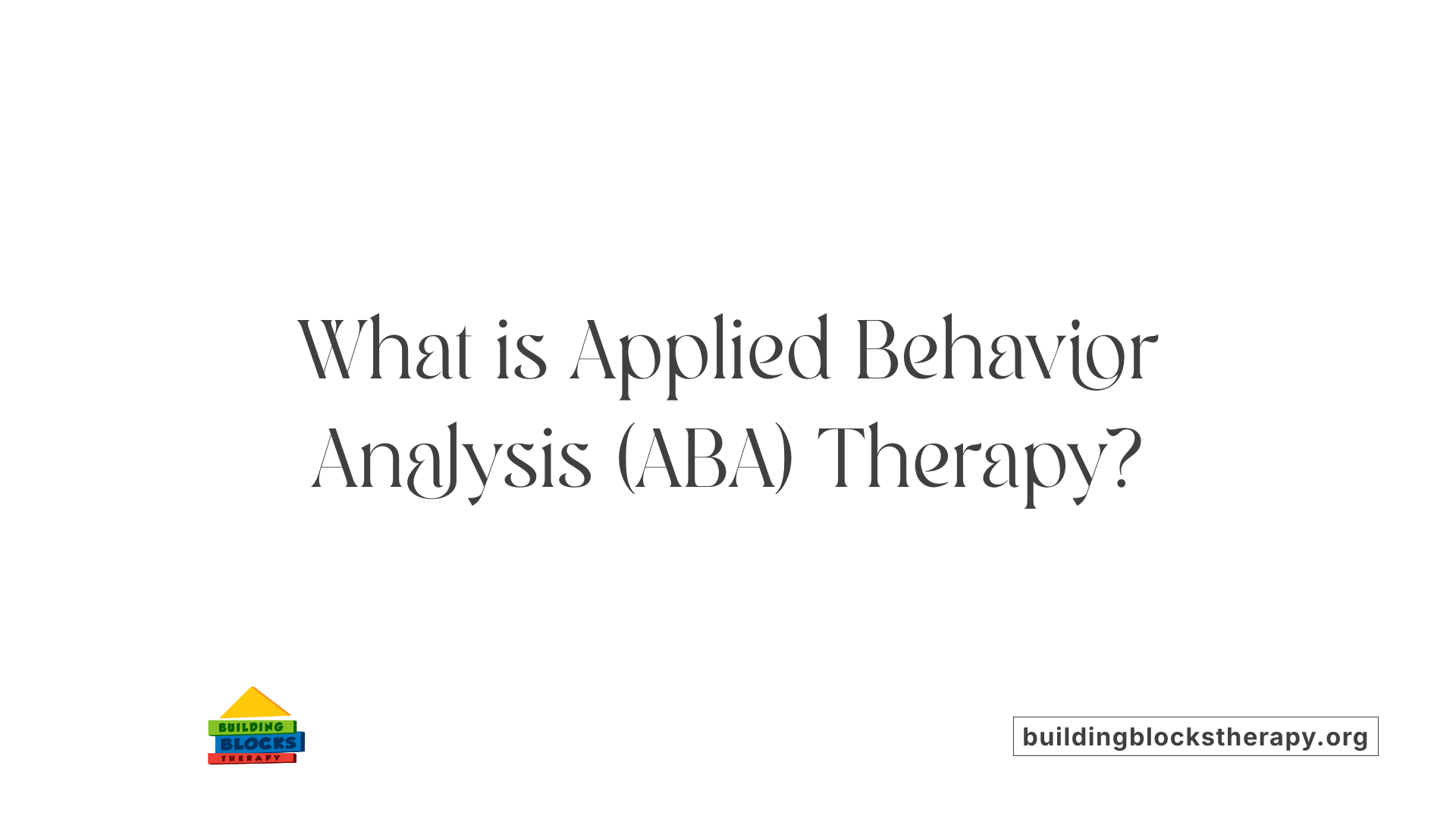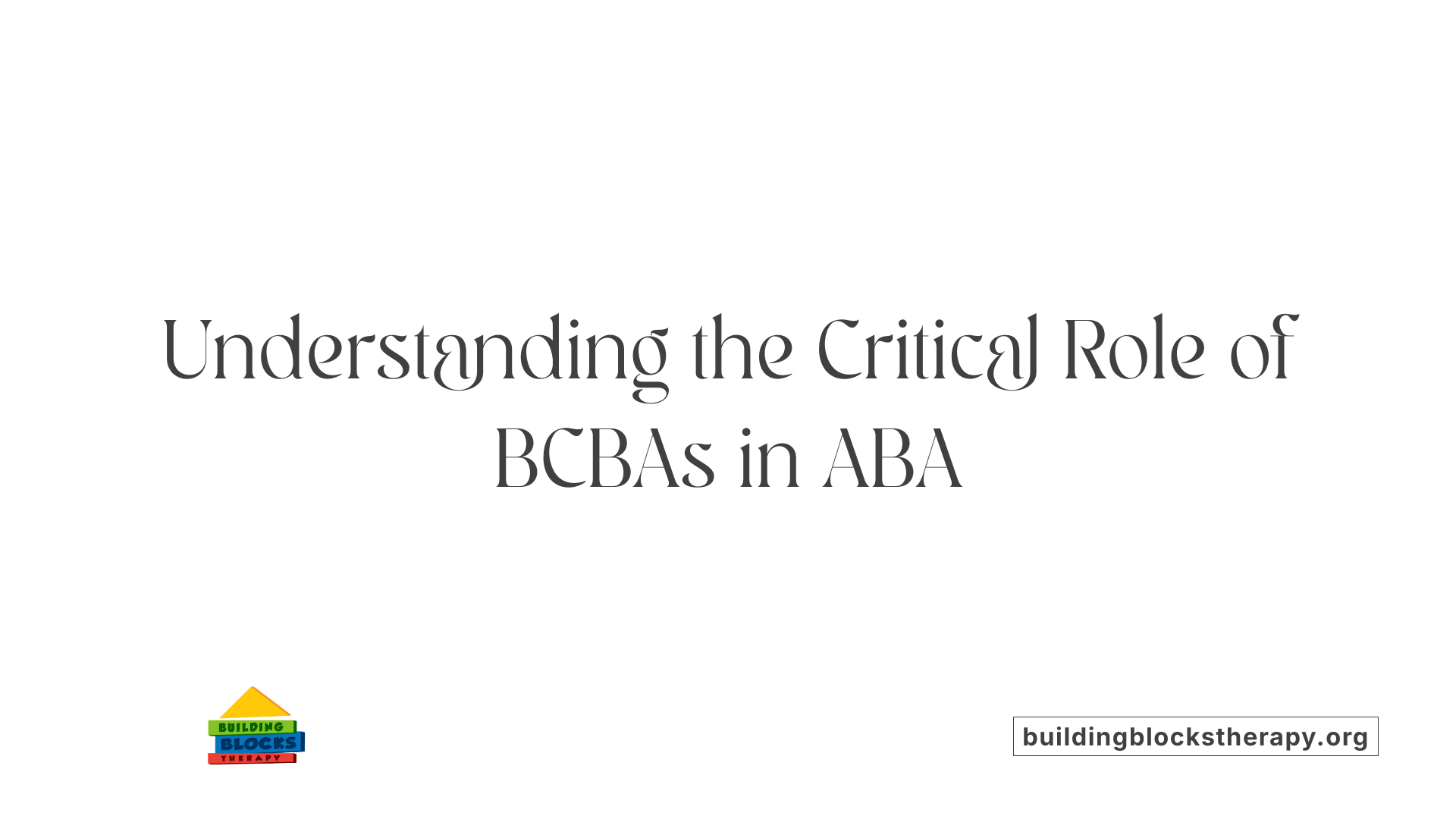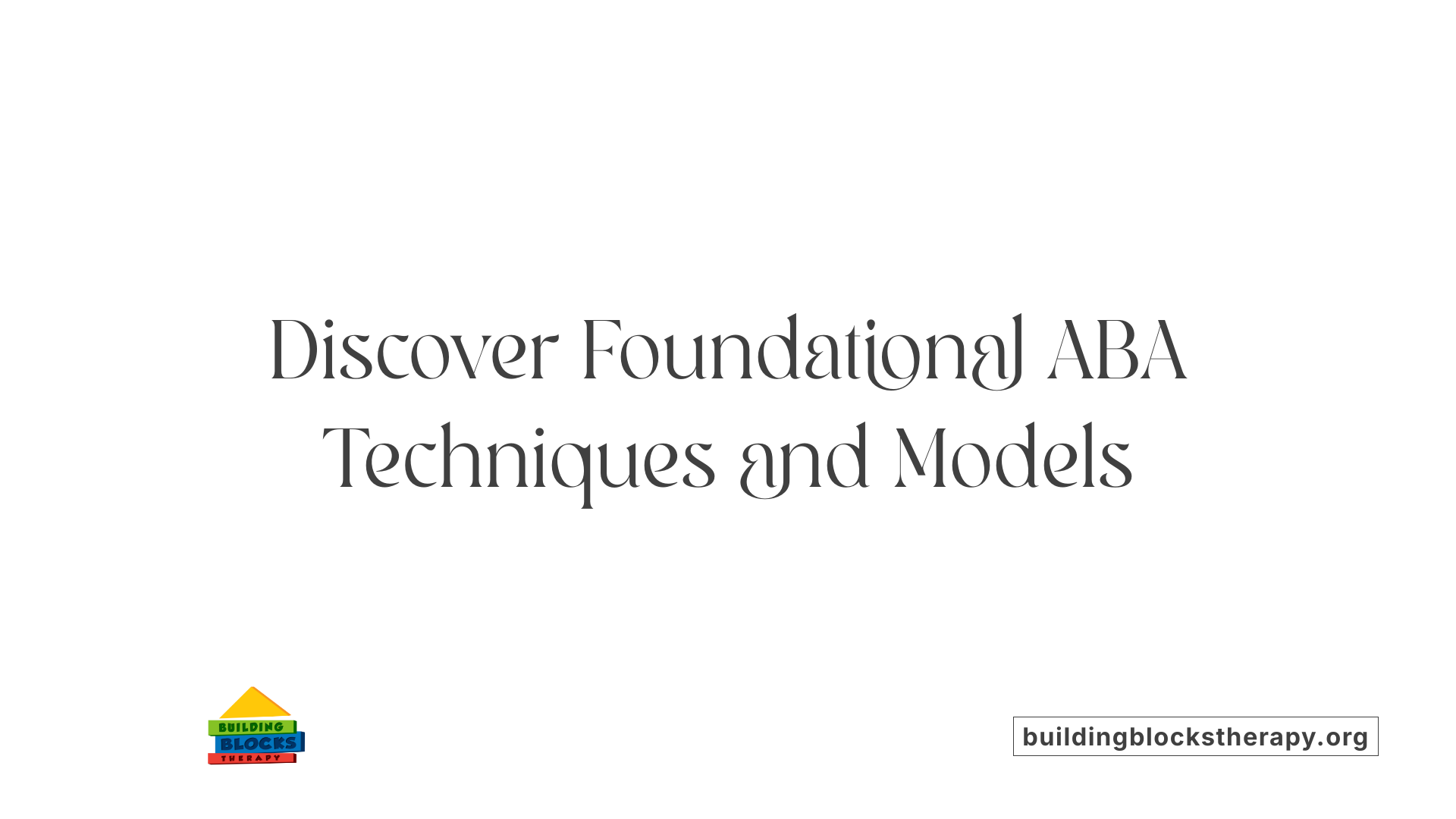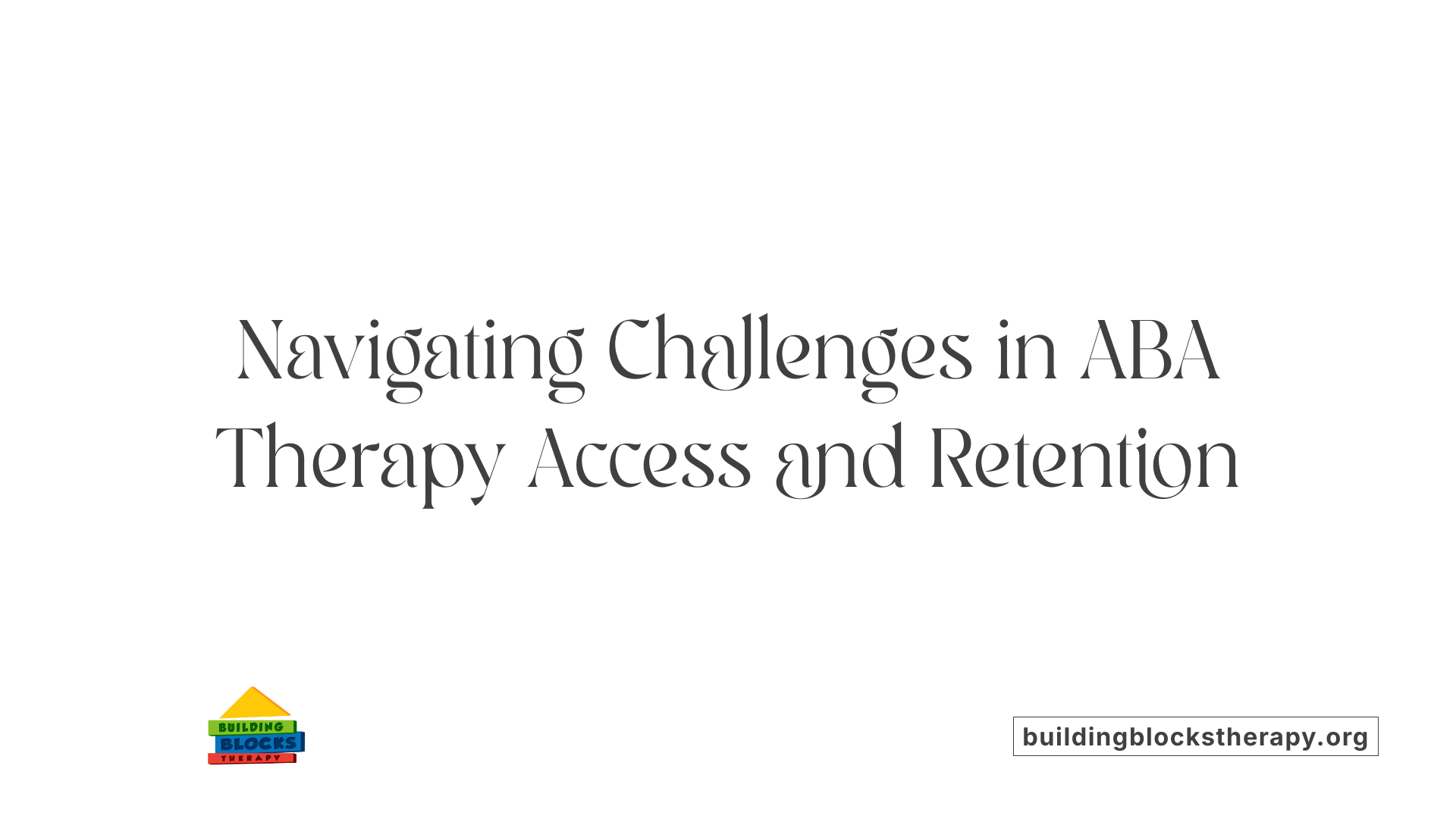How ABA Therapy Supports Children with Autism Spectrum Disorder
Unlocking Potential: The Transformative Impact of ABA Therapy on Autism

Understanding ABA Therapy and Its Role in Autism Support
Applied Behavior Analysis (ABA) therapy stands as a premier evidence-based intervention designed to support children with Autism Spectrum Disorder (ASD). Rooted in decades of scientific research, ABA harnesses principles of learning and behavior to foster meaningful improvements in communication, social interaction, and daily living skills. This article explores how ABA therapy supports children with autism by detailing its methodologies, outcomes, and considerations for choosing qualified providers.
What is Applied Behavior Analysis (ABA) Therapy?

Definition of ABA therapy
Applied Behavior Analysis (ABA) therapy is a scientifically supported treatment rooted in the study of learning and behavior. It focuses on increasing helpful behaviors and reducing harmful or unhelpful behaviors by applying behavioral principles such as positive reinforcement and careful analysis of antecedents and consequences.
Core principles and methods
ABA employs techniques like breaking skills into small, manageable steps and using positive reinforcement to encourage desired behaviors. Methods such as Discrete Trial Training (DTT), Pivotal Response Treatment (PRT), and the Early Start Denver Model (ESDM) are typical approaches that use structured teaching, natural play contexts, and multiple behavior-change strategies.
Role of behavior analysts
A Board Certified Behavior Analyst (BCBA) oversees ABA programs, conducting detailed assessments and designing individualized treatment plans tailored to each child's strengths and needs. They continuously collect data to measure progress and adjust strategies accordingly.
Individualization and data-driven progress monitoring
ABA therapy is highly personalized, with goals and sessions crafted specifically for each child. Progress is tracked rigorously through data collection, ensuring treatment effectiveness and allowing dynamic modifications to the program.
Integration into natural environments
ABA is often integrated into natural settings, like home or school, to encourage learning within everyday routines. Techniques such as natural environment training and play therapy promote skill generalization and help children develop communication, social, and life skills in real-world contexts.
ABA therapy is recognized as an evidence-based intervention for autism spectrum disorder, aiming to empower children to become more independent and engaged members of their communities.
How ABA Therapy Helps Children with Autism
What are the behavioral goals of ABA?
ABA (Applied Behavior Analysis) therapy centers on increasing helpful behaviors and decreasing harmful or unhelpful ones. It aims to teach children positive skills like communication and social interaction while reducing behaviors that interfere with learning or safety. This targeted approach helps children with autism develop necessary life skills and improve day-to-day functioning.
Which skill areas does ABA improve?
ABA therapy supports growth across multiple important domains:
- Language and Communication: Enhances understanding, expressive language, and the use of social cues.
- Social Skills: Builds interactions, friendship-making, and group participation.
- Daily Living Skills: Teaches practical tasks such as dressing, eating, personal hygiene, and grooming.
- Academic Skills: Supports attention, memory, and school-related abilities.
- Behavioral Regulation: Helps children learn to manage emotions and express feelings constructively.
How does ABA increase positive behaviors and reduce challenges?
Techniques like positive reinforcement reward desired behaviors to encourage their repetition. The ABC model (Antecedent-Behavior-Consequence) helps therapists analyze triggers and outcomes to modify behaviors effectively. Methods include discrete trial training (structured tasks), natural environment teaching, and use of visual aids. These strategies create motivating learning opportunities tailored to each child.
What is the impact of early and intensive intervention?
Research shows that ABA started early (ideally before age 4) and delivered intensively (20+ hours per week) leads to significant developmental gains. Early intervention boosts cognitive, language, and social skills, enhancing children’s ability to engage with others and participate in community life. It also lays a foundation for long-term success and independence.
What are the long-term benefits and real-life applications of ABA?
Over time, consistent ABA therapy improves intellectual functioning, adaptive behaviors, and practical skills needed for adulthood. Children learn to cope with social cues, manage behaviors, and handle everyday challenges confidently. Tailored programs integrate family involvement to extend learning beyond therapy settings, promoting generalization and lasting positive impact on quality of life.
| Aspect | Description | Real-Life Impact |
|---|---|---|
| Behavioral Focus | Increase helpful behaviors; reduce harmful ones | Improved safety, learning, and social functioning |
| Skill Areas | Communication, socialization, daily living | Better independence, friendships, academic success |
| Intervention Approach | Positive reinforcement, ABC model, individualized plans | Enhanced motivation, tailored progress monitoring |
| Timing & Intensity | Early start, 20+ hours/week | Greater developmental gains and lasting benefits |
| Family & Environment | Parent involvement, natural environment training | Skills generalized across home, school, social settings |
The Role of the Board Certified Behavior Analyst (BCBA) in ABA Therapy

Qualifications and Responsibilities of BCBAs
ABA therapy is primarily provided by Board Certified Behavior Analysts (BCBAs), who possess specialized education and certification demonstrating expertise in applied behavior analysis and autism intervention. BCBAs are responsible for assessing each child's unique needs, then designing and implementing individualized treatment plans. Their role requires a deep understanding of learning theory, behavior modification techniques, and developmental challenges commonly associated with autism spectrum disorder (ASD).
Personalized Treatment Planning
A critical component of a BCBA's role is developing tailored ABA programs. They conduct detailed assessments to identify behaviors to increase or decrease, and set measurable goals across domains like communication, social skills, and daily living. Treatment plans are adjusted continuously based on ongoing data collection and observation to maximize effectiveness for each child.
Supervision and Quality Assurance
BCBAs oversee therapy delivery by training and supervising Behavior Technicians or Registered Behavior Technicians who provide direct services. This supervision ensures adherence to evidence-based methods, ethical standards, and safety protocols. BCBAs regularly monitor progress through data analysis, making modifications to therapeutic approaches when necessary to maintain quality and positive outcomes.
Collaboration with Families and Caregivers
An essential aspect of ABA success lies in involving families and caregivers. BCBAs educate and coach them on implementing behavioral strategies at home and in community settings. This collaboration fosters consistency, encourages generalization of skills, and strengthens family bonds, ultimately supporting the child's growth beyond therapy sessions.
| Aspect | Role of BCBA | Impact on Therapy |
|---|---|---|
| Qualifications | Certified experts trained in behavior analysis | Ensures professional, evidence-based treatment |
| Personalized Planning | Creates individualized ABA programs based on detailed assessments | Tailors interventions to child's unique strengths and challenges |
| Supervision | Oversees direct therapists and ensures fidelity to treatment models | Maintains therapy quality and ethical standards |
| Family Collaboration | Trains and supports parents/caregivers in behavior management | Enhances consistency and skill generalization |
Core ABA Techniques and Models

What is Positive Reinforcement and Why Is It Important?
Positive reinforcement is fundamental in ABA therapy. It encourages skill development by rewarding desired behaviors, increasing the likelihood these behaviors will be repeated. This method helps children acquire new skills and maintain positive behaviors in various settings.
How Does the ABC Model Help in ABA?
The ABC model stands for Antecedent-Behavior-Consequence. It focuses on understanding what happens before a behavior (antecedent), the behavior itself, and the result (consequence). This analysis helps therapists modify behaviors effectively by manipulating antecedents and consequences to promote positive behavior change.
What Is Discrete Trial Training (DTT)?
DTT uses structured, one-on-one teaching sessions where tasks are broken down into small steps. Each step is taught with clear instructions followed by reinforcement for correct responses. DTT has moved away from punishment and focuses on positive reinforcement to teach new skills systematically.
What Is Pivotal Response Training (PRT)?
PRT is a play-based method that integrates learning into natural environments. It targets pivotal areas such as motivation and self-management. By using the child’s interests and providing reinforcement naturally during activities, it encourages spontaneous communication and social interaction.
What Does the Early Start Denver Model (ESDM) Involve?
ESDM combines the strengths of DTT and PRT. It uses play-based activities targeting multiple developmental areas like language, cognition, and social skills. Designed for young children, ESDM is tailored to each child’s unique needs and emphasizes naturalistic, relationship-based learning.
What Other Techniques Are Common in ABA?
Additional ABA strategies include:
- Prompting: Providing cues to encourage correct responses.
- Extinction: Reducing unwanted behaviors by withholding reinforcement.
- Video Modeling: Using videos to demonstrate desired behaviors.
- Picture Exchange Communication System (PECS): Teaching communication through pictures to enhance language and interaction.
These techniques complement the core models, creating a comprehensive toolkit for effective ABA therapy.
| Technique/Model | Description | Primary Objective |
|---|---|---|
| Positive Reinforcement | Rewarding positive behavior to increase its frequency | Skill acquisition and retention |
| ABC Model | Analyzing Antecedent, Behavior, and Consequence | Behavior understanding and modification |
| Discrete Trial Training | Structured, stepwise teaching with reinforcement | Systematic skill teaching |
| Pivotal Response Training | Naturalistic, interest-based learning | Motivating generalization of skills |
| Early Start Denver Model | Play-based, comprehensive intervention early in development | Multi-domain developmental gains |
| Prompting | Providing cues to elicit correct responses | Encourage correct behavior |
| Extinction | Withholding reinforcement to reduce behavior | Decrease unwanted behaviors |
| Video Modeling | Showing behavior models through videos | Promote imitation and learning |
| PECS | Using pictures to support communication | Enhance expressive and receptive communication |
Early Intervention and Intensity in ABA Therapy

Why is it important to start ABA therapy before the age of six?
ABA therapy is most effective when started early, ideally before age six, with research showing that initiating treatment in preschool years maximizes skill acquisition. This early start taps into critical developmental windows, allowing children to make significant improvements in communication, social skills, and adaptive behaviors.
What intensity and duration of ABA therapy are recommended?
Effective ABA typically involves intensive programs requiring 20 to 40 hours of therapy per week. Long-term intervention—often spanning 12 to 24 months or more—is recommended to yield meaningful developmental progress. Such high-intensity and sustained ABA therapy helps embed new skills and behaviors more reliably.
How does early and intensive intervention affect developmental outcomes?
Early and intensive ABA programs have been associated with clinically meaningful gains, including improved intellectual functioning, language development, socialization, and daily living skills. Studies report medium to large effect sizes when therapy is personalized and comprehensive. Even children with low initial adaptive behaviors show significant improvement, with substantial increases in adaptive behavior composite scores documented over 12 months.
What are the challenges in therapy retention and adherence?
Despite its benefits, many children do not remain in ABA therapy long-term. Only about 46% continue treatment for 24 months, with discontinuation often unrelated to progress. Factors such as family support, provider availability, reimbursement rates, and logistical issues heavily influence adherence to therapy. For example, children with married or partnered parents and prior special education history tend to stay in treatment longer, highlighting the importance of family and systemic support in sustaining therapy.
Selecting the Right ABA Therapy Provider
What qualifications should parents look for when choosing an ABA therapy provider?
Parents should prioritize providers that employ professionals with recognized credentials such as Board Certified Behavior Analysts (BCBAs) and Registered Behavior Technicians (RBTs). These individuals have undergone rigorous training to deliver ABA therapy tailored to each child's age and unique needs.
Customized and comprehensive treatment plans
A reputable provider will develop personalized treatment plans focusing on socially significant behaviors. These plans include clear, measurable goals and use data-driven methods to track progress, ensuring interventions are tailored and adjusted based on the child’s ongoing development.
Supervision and communication practices
Effective ABA programs are overseen by licensed BCBAs who provide ongoing supervision to ensure therapy quality and fidelity. Transparent communication about objectives, methods, and progress is essential for parents to stay informed and actively involved in their child's treatment.
Safety, privacy, and family involvement
Trustworthy providers implement strict safety protocols and privacy measures to protect children during sessions. Family involvement is strongly encouraged, promoting consistency of skills across settings and enhancing treatment outcomes through collaboration.
Assessing approachability and rapport
Parents should observe sessions when possible to assess the provider's interaction style, the clinician’s approachability, and the child’s comfort level. A positive, supportive relationship between therapist, child, and family significantly impacts therapy effectiveness.
Selecting an ABA therapy provider with appropriate credentials, comprehensive and individualized plans, thorough supervision, robust safety practices, and collaborative communication ensures the best foundation for a successful therapy experience.
ABA Therapy's Impact on Life Skills and Independence
How Does ABA Improve Daily Living Skills?
ABA therapy plays a crucial role in helping children develop daily living skills essential for independence. These skills encompass tasks such as dressing, using the bathroom, personal hygiene, grooming, eating, and even more complex activities like meal preparation and time management. By employing positive reinforcement techniques, ABA encourages children to consistently practice and master these self-care behaviors.
How Does ABA Foster Behavioral Management and Coping Strategies?
Beyond practical skills, ABA teaches children to manage their behaviors and emotions effectively. Through natural environment training and play therapy, children learn to cope with feelings constructively and express themselves in appropriate ways. This behavioral management enhances their ability to handle everyday stresses and social challenges.
In What Ways Does ABA Enhance Social Skills?
ABA therapy significantly improves social interaction capabilities by promoting peer connections, group learning, and understanding of social cues. Children learn to interpret body language, recognize sarcasm, and develop communication skills that foster meaningful friendships. Group therapy sessions and social skill-building activities are integral parts of this process.
How Does ABA Prepare Children for Adulthood?
One of ABA’s main objectives is preparing children for a successful transition into adulthood. It focuses on teaching behavioral management, understanding social nuances, and handling real-life situations with confidence. This preparation helps children gain independence and equips them with the skills needed to navigate complex adult environments.
ABA therapy’s individualized approach ensures that these developmental areas are tailored to each child’s unique strengths and needs, maximizing effectiveness. Overall, ABA supports children with autism in achieving greater independence and improved quality of life through targeted life skill development and social competence enhancement.
Challenges and Considerations in ABA Therapy Implementation

What Barriers Affect Access and Retention in ABA Therapy?
Accessing and maintaining ABA therapy services can be challenging for many families. Despite insurance mandates, only about 66% of children referred for ABA actually initiate treatment, and less than half remain in services after 24 months. Factors such as provider availability, service demand, reimbursement rates, and logistical issues often interfere with ongoing engagement. These barriers highlight gaps between clinical research settings and community practice.
How Do Family Support and Socioeconomic Factors Influence ABA Continuation?
Family dynamics and socioeconomic conditions play a significant role in ABA therapy retention. Children with a history of special education or those whose parents are married or partnered are more likely to stay in therapy longer. This suggests that social support within the family and stable home environments contribute positively to sustained treatment. Conversely, lack of such support may lead to premature discontinuation.
What Are the Limitations in Current ABA Research?
Although meta-analyses confirm ABA's effectiveness on intellectual and adaptive skills, most studies have low methodological quality, which may introduce bias. Few rigorous trials directly compare ABA to alternative or control interventions, representing a gap in high-quality evidence. Moreover, there is a notable lack of research evaluating quality of life outcomes for children receiving ABA.
Why Is Continued Research on ABA's Long-Term Effects and Cost-Effectiveness Important?
Ongoing large-scale, long-term, prospective randomized controlled trials are needed to better understand ABA's sustained impact and cost-effectiveness. Standardized outcome measures and comprehensive care frameworks remain absent. Such research is essential to optimize treatment protocols, inform policy, and ensure that ABA interventions deliver maximum benefits for diverse populations while efficiently utilizing resources.
The Broader Context: ABA Among Autism Interventions
How Does ABA Compare to Other Therapeutic Approaches?
Applied Behavior Analysis (ABA) stands out as an evidence-based behavioral intervention primarily focused on modifying behaviors by understanding their antecedents and consequences. Unlike speech and language therapy, which specifically targets verbal and nonverbal communication skills, or occupational therapy, which enhances independence in daily activities such as dressing and social interactions, ABA integrates behavioral principles to improve a wide range of skills, including social, communication, and adaptive behaviors. Educational programs like the TEACCH approach emphasize classroom structure and visual strategies to support learning, while developmental models and social-relational approaches focus on fostering social bonds and emotional skills, sometimes through methods like 'Floor Time' or Relationship Development Intervention (RDI).
What Role Do Complementary and Alternative Treatments Play?
While ABA and traditional therapies form the core of autism intervention, complementary treatments such as special diets, herbal supplements, animal therapy, arts therapy, mindfulness, and relaxation techniques are also used by some families. These methods aim to supplement standard care but should always be discussed with healthcare providers to ensure safety and appropriateness.
How Is ABA Recognized in the Field?
ABA is widely regarded as a gold-standard, evidence-based treatment for autism spectrum disorder. It is endorsed by authoritative bodies such as the US Surgeon General and the American Psychological Association. Decades of research support its effectiveness in improving intellectual functioning, adaptive behavior, and communication, especially when started early and delivered intensively.
How Have ABA Practices Evolved to Address Past Criticisms?
Although ABA has faced criticism historically—particularly concerning the use of punishment and efforts aimed at normalization—modern ABA focuses strongly on positive reinforcement and teaching functional, meaningful skills. Current approaches emphasize individualized plans that respect each child's unique strengths and challenges and utilize techniques that promote naturalistic learning and social engagement rather than punitive measures.
| Intervention Type | Focus Area | Approach Highlights |
|---|---|---|
| ABA | Behavioral modification, adaptive skills | Positive reinforcement, individualized, evidence-based |
| Speech & Language Therapy | Communication skills | Verbal/non-verbal communication, aids understanding |
| Occupational Therapy | Daily living skills, independence | Sensory integration, motor skills, self-care routines |
| TEACCH | Structured educational environment | Visual supports, consistency in classrooms |
| Developmental/Social-relational | Social, emotional bonding | Parent involvement, play-based, relationship-focused |
| Complementary/Alternative | Supplemental support | Diets, animal therapy, mindfulness, requires medical oversight |
The Lasting Benefits of ABA Therapy for Children with Autism
ABA therapy remains the cornerstone of autism support through its scientifically grounded, individualized interventions that foster skill development and independence. By employing a range of evidence-based techniques tailored to each child's unique needs, ABA enables children with autism to improve communication, social interaction, and everyday functioning. Early and intensive therapy, guided by qualified professionals, maximizes these benefits and supports families in the treatment journey. Despite challenges in access and retention, ongoing research and evolving practices continue to enhance ABA's effectiveness and reach, affirming its critical role in improving the lives of children with Autism Spectrum Disorder.
References
- Applied Behavior Analysis (ABA)
- Applied Behavior Analysis in Children and Youth with Autism ...
- 6 Benefits of ABA Therapy for Children with Autism
- 5 Benefits Of ABA Therapy For Autism
- Patient Outcomes After Applied Behavior Analysis for ...
- Treatment and Intervention for Autism Spectrum Disorder
- Applied Behavior Analysis (ABA)





